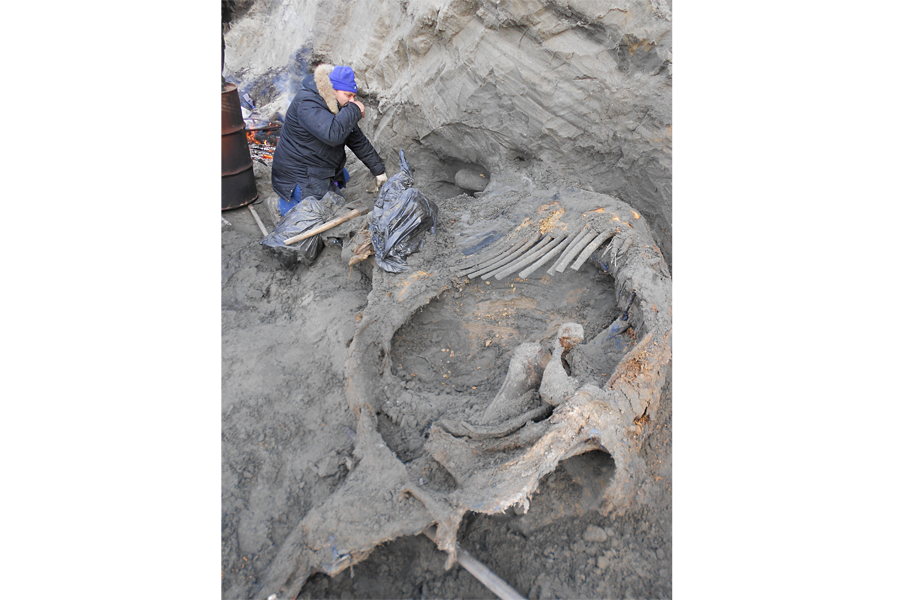What can a 45,000-year-old mammoth carcass say about human history?
Loading...
Living above the Arctic circle provides a suite of challenges for humans, particularly during the last Ice Age. They would have struggled to keep warm and gather the necessary resources to survive the severe landscape, or so we thought.
New research suggests anatomically modern humans may have lived remarkably far North in central Siberia as early as 45,000 years ago, a feat that would mean our ancestors were more technologically advanced than we previously believed.
And this finding could have significant implications for the history of human migration, including the peopling of the Americas, according to a new paper published Friday in the journal Science.
Scientists announce this discovery based on clues from a strange source: a dead mammoth. The researchers unearthed mammoth bones with distinctive cut marks that suggested this animal fell victim to a band of hunters. Bits of stone, as if broken from a weapon, were even embedded in some of the slices.
"This is well-supported evidence for humans being that far North at 45,000 years ago," study lead author Vladimir Pitulko tells The Christian Science Monitor in an interview.
This isn't the first time scientists have discovered evidence that humans lived in Siberia at the time. In 2014, scientists sequenced the genome of a 45,000-year-old man discovered in western Siberia, but he was discovered around the 57 degrees North latitude line. The new find extends that populated region to nearly 72 degrees North.
"That's a huge difference which gives us a new impression of how people would be spreading across the planet," Dr. Pitulko says.
A mammoth discovery of human adaptability
Knowing modern humans were surviving in the challenging environment that is the Arctic so long ago says a lot about their technological capabilities and adaptability, says Ted Goebel, interim head of the department of anthropology at Texas A&M University, who was not affiliated with the study. If they were successfully populating the region, he says, "They were very quick on their feet in terms of developing new technologies and adapting to new environmental conditions that they had never faced before."
And it wasn't just the Arctic. Around the same time, modern humans were migrating into high-elevation regions, the islands of Indonesia and deserts across Eurasia, Dr. Goebel points out in an interview with the Monitor.
From Siberia to the Americas
This discovery could actually help explain the peopling of the Americas. The researchers' findings situate human populations quite nearby, or perhaps along, the path that humans took from Eurasia to the Americas.
What is now the Bering Strait was a strip of land during the last Ice Age, as the glaciers drew water out of the oceans, lowering sea levels. The so-called land bridge stretched from Siberia to present-day Alaska.
But for humans to migrate over the land bridge, they would have to pass through parts of the Arctic.
"In order for humans to get to the Americas, they had to have first developed these Arctic technologies and adaptations," Goebel says. "Not because in places like Texas, where I live, you need to know how to live in the Arctic, but to get to Texas, you had to pass through the Arctic. There's this need for that condition first and we used to think that that condition developed 20,000 years ago."
So if humans were able to survive in such an environment and were nearby some 45,000 years ago, perhaps humans made it to present-day Alaska and beyond much earlier than previously thought.
Which humans?
"It's a smoking gun," Goebel says of the find. Humans were living far north in Siberia some 45,000 years ago.
But, with only evidence of mammoth hunters, we can't be completely sure that it was modern humans, Homo sapiens, that made the cut marks on the bones. Perhaps it was a late-surviving group of an archaic human species in the region, Goebel suggests.
Neanderthals and their close cousins, Denisovans, could be other candidates. What it hinges on is whether the archaic humans were capable of the technologies necessary to hunt the mammoth and survive so far North. Most scientists don't think they were so advanced.
If researchers discover human remains nearby, that would resolve the dilemma, Goebel says. But, "I'd presume these were modern humans too," he says.








